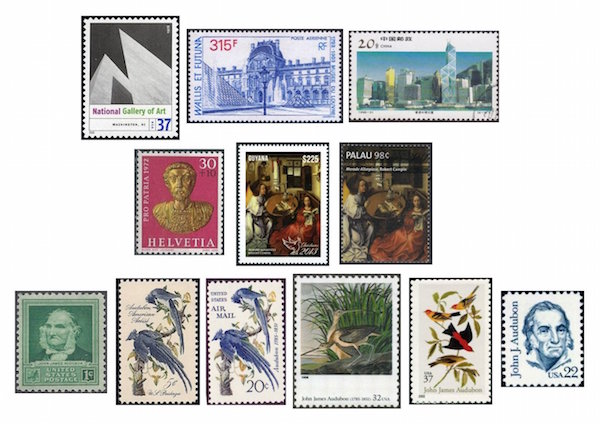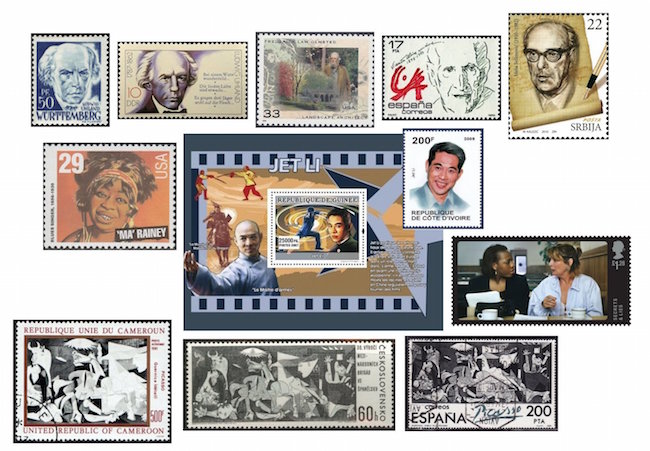The Arts on the Stamps of the World — April 26
An Arts Fuse regular feature: the arts on stamps of the world.

By Doug Briscoe
Welcome to a huge philatelic celebration on this, the birthday of Marcus Aurelius, John James Audubon, Eugène Delacroix, Ludwig Uhland, Frederick Law Olmsted, Ma Rainey, and I.M. Pei, who has a very special birthday indeed, as he turns 100 today! (Nothing philatelic for Bernard Malamud or Carol Burnett as of yet, but I suspect their day will come.)
Let’s begin with congratulations to I.M. (Ieoh Ming) Pei on his 100th birthday! He was born in Guangzhou (Westerners called it Canton in those days), but the family moved to Hong Kong when he was an infant, then, when he was ten, to Shanghai. In 1935 he went to study at at the University of Pennsylvania, then at MIT, where in later years he would leave his mark in several structures: the Green Building (1964), the Dreyfus Chemistry Building (1970), the Ralph Landau Chemical Engineering Building (1976), and the Wiesner Building (1984). Massachusetts also benefited from Pei’s Government Center Master Plan, the Hancock Tower, the West Wing of the Museum of Fine Arts, and the John F. Kennedy Library, which he himself considered his most important commission. None of these is represented on stamps, but his East Building (1978) of the National Gallery in Washington, D.C., is featured on a 2005 sheet of American architectural landmarks. So, too, his Louvre Pyramid (1993) appears on a French stamp and his 1989 Bank of China Tower (the tallest building seen in this Hong Kong skyline) on one from China.
We salute Emperor Marcus Aurelius (26 April 121 – 17 March 180 CE) for his Meditations. The nice thing about being emperor is that people remember your birthday even after thousands of years.
Moving forward about fifteen hundred years, we come to Robert Campin, called by Wikipedia “the first great master of Flemish and Early Netherlandish painting.” And yet we are not entirely certain that we know any of his work. Born some time around 1375, he died on this date in 1444, after having been the most prominent painter in Tournai for 28 years. The image we see on the stamps of Guyana and Palau was once thought to be a work of Rogier van der Weyden, then was attributed to the anonymous “Master of the Mérode Triptych”, who was later styled the Master of Flémalle after more panels were discovered, and now the Master of Flémalle is believed to have been Robert Campin, whose name and reputation are well documented, even though today not a single piece can be indisputably assigned to him. The Mérode Triptych is housed at the Cloisters.

An artist about whom we know a great deal more, of course, is John James Audubon (April 26, 1785 – January 27, 1851). He was born out of wedlock in Saint-Domingue (Haiti) to a French naval officer and his chambermaid Jeanne Rabine and named Jean Rabin. She died when Jean was still an infant, and at age six he went to live with his father in France. He was legitimized and renamed Jean-Jacques Fougère Audubon. His father arranged for the eighteen-year-old to avoid conscription during the Napoleonic Wars by emigrating to America, where Jean-Jacques changed his name one last time, anglicizing it to John James Audubon. He turned to ornithology, determined to make realistic and accurate illustrations of his subjects. The culmination of his efforts was The Birds of America, published between 1827 and 1839. Six of the birds Audubon painted are now extinct. His work is a favorite topic on stamps of the world, but we begin with the US issues. These are from 1940 (portrait), 1963 (Collie’s magpie jays, identified by Audubon as “Columbia jays”, reused as an airmail stamp in 1967), 1998 (long-billed curlew), 2002 (scarlet and Louisiana tanagers), and finally another portrait from 1985. But, of course, I can’t leave it there: so in the next collage we offer four stamps from a large set from Nevis on either side of a beautiful sheet from Tanzania; then two more minisheets from Bhutan and Antigua with stamps from the Solomon Islands and Barbuda between them.
Two great painters in a row as we move on to Collage #3 and Audubon’s contemporary (and countryman) Eugène Delacroix (1798 – 13 August 1863) and present a French stamp of his 1837 Self-portrait, one from Ras al Khaima showing his famous portrait of Chopin (1838), with a Polish monochrome version next to it, three animal studies on stamps from the Congo, a small detail from Entry of the Crusaders into Constantinople (1840) and one from Jacob Wrestling with the Angel (1854-61), both of these last on more recent French issues. At bottom center we place one of Delacroix’s most recognizable canvases, Liberty Leading the People (1830). Although I know of no stamp for it, in view of one of our other birthday subjects today, I must provide a link to The Last Words of the Emperor Marcus Aurelius (1844).

On today’s fourth and final collage we begin with German poet and polymath Johann Ludwig Uhland (1787 – 13 November 1862), one of the pioneers of the study of philology, a literary historian, professor, and liberal politician who supported the 1848 Revolution. His poems were set many hundreds of times, often by the greatest composers. The earliest such setting I can identify is Schubert’s “Frühlingsglaube,” D.686 (1820), Schubert’s only setting of this poet. In subsequent years, Felix Mendelssohn wrote at least three a cappella choral songs on Uhland texts, and his sister Fanny composed a few Uhland Lieder for voice and piano. Schumann repeatedly turned to Uhland for inspiration, in songs and choruses as well as for his late (and rarely heard) large scale ballads for voices with orchestra. I found seven songs by Brahms, four by Liszt, and six by Richard Strauss, besides examples by Grieg, Busoni, Vieuxtemps (!), and Othmar Schoeck. Some of the poems were translated into English by Longfellow, and Edward Elgar wrote a large “symphony/cantata” on one of them, “The Black Knight” for the Three Choirs Festival. As a note of philatelic interest, the stamp at left, the blue one, was issued under Allied occupation in 1948.
Now we come to the pioneering American landscape architect Frederick Law Olmsted (April 26, 1822 – August 28, 1903). His most famous accomplishment was New York’s Central Park, but Bostonians know him for the Emerald Necklace and possibly for Elm Park in Worcester, thought by some to be the first municipal park in the United States, and for Forest Park in Springfield, noted for having the first public wading pool. Olmstead was also a conservationist, journalist, social critic (e.g., abolitionist), and tireless public administrator who provided medical services for the Union Army during the Civil War. The USPS issued a handsome stamp for him in 1999.
April has seen a spate of Nobel Prize winners in these pages: just within the past few days we honored Halldór Laxness and Carl Spitteler, and earlier in the month Gabriela Mistral, Anatole France, and José Echegaray. Now we salute gay Spanish poet Vicente Aleixandre (26 April 1898 – 14 December 1984), who won the award in 1977. Marked by surrealism and melancholy, his poetry first appeared in book form in 1928, but his strong individual voice took a few more years to develop. The surrealism gave way to simplicity in the 40s, was enriched by sociological themes in the 50s and 60s, and turned to a contemplation of old age and mortality in his final period.

Another writer born on April 24 was Yugoslavian novelist Mehmed “Meša” Selimović (1910 – 11 July 1982), who despite his heritage as a Bosnian Muslim regarded himself as primarily a Serb. Like Uhland, he was interested in philology. During World War II he fought with the partisans and was arrested in 1943, thereafter joining the Communist Party. Something of a late bloomer, Selimović was forty before he published his first book, a short story collection, in 1950. His finest work, and a milestone in postwar Yugoslav literaure, is the novel Death and the Dervish (1966).
The fourth collage’s second row begins with blues singer Ma Rainey, who seems to have been born in September 1882, though she herself cited April 26, 1886, and since we have no specific accurate date I thought we’d include her today. Her birth name was Gertrude Malissa Nix Pridgett, and she was still very young (only 18 or 22) when she took to calling herself Ma Rainey, having married musician Will Rainey in 1904. She was not only one of the first to make records of the blues (thus earning the sobriquet Mother of the Blues) but also one of the more prolific—she turned out a hundred recordings between 1923 and 1928. One of these was “Prove It On Me”, seen as an affirmation of lesbianism. Rainey worked with Louis Armstrong and Tommy Dorsey and retired in 1935. She died four years later, on December 22, 1939. One of August Wilson’s plays, Ma Rainey’s Black Bottom (1982), is a reimagination of one of her recording sessions. “Black Bottom” is the name of a song she recorded in 1927. (Wilson’s birthday happens to be tomorrow. No stamp yet.)
We have two actors on stamps today, martial artist Jet Li (born Li Lianjie in 1963), and English actress Marianne Jean-Baptiste (born 1967 to parents from the Caribbean), who is also a singer, composer, and director. She played Hortense Cumberbatch in Secrets & Lies (1996), for which she was nominated for a Best Supporting Actress Oscar, and Vivian Johnson on the American television series Without a Trace.
In memoriam the victims of the bombing of Guernica, an atrocity that took place on this day eighty years ago and that was brought with immediacy to the public eye in one of Picasso’s most famous paintings. Stamps from Cameroun, Czechoslovakia, and Spain recall the event with reproductions of the art work.
A graduate of the University of Massachusetts with a B.A. in English, Doug Briscoe worked in Boston classical music radio, at WCRB, WGBH, and WBUR, for about 25 years, beginning in 1977. He has the curious distinction of having succeeded Robert J. Lurtsema twice, first as host of WGBH’s weekday morning classical music program in 1993, then as host of the weekend program when Robert J.’s health failed in 2000. Doug also wrote liner notes for several of the late Gunther Schuller’s GM Recordings releases as well as program notes for the Boston Classical Orchestra. For the past few years he’s been posting a Facebook “blog” of classical music on stamps of the world, which has now been expanded to encompass all the arts for The Arts Fuse.
